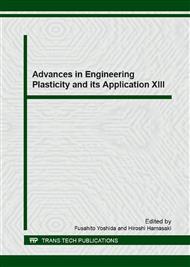p.433
p.439
p.445
p.451
p.456
p.465
p.471
p.477
p.483
Computational Simulation of Scale-Dependent Non-Uniform Deformation Behavior of Polymer Foam
Abstract:
Polymer foam is widely used in the engineering field because of various functions such as lightweight, shock absorbing, insulation and so on. However, the strength of the material dramatically decreases with the increase in the volume fraction of the foam. Furthermore, deformation behavior of the material strongly depends on the microscopic heterogeneous structure consisting of foam and polymer wall. In the present study, a micro-to macroscopic deformation behavior of polymer foam is modeled using the rate-form second-order homogenization method. To model the microscopic structure consisting of foam and polymer wall, a hexagonal shape periodic structure was used, and the molecular chain network theory was used to represent an elastic-viscoplastic deformation behavior of polymer wall. The effect of the sizes of macroscopic and microscopic structures on the mechanical behavior of LDPE foam was investigated by computational simulation of bending of cantilever. The bending resistance, in other words, resistance to the strain gradient clearly depended on the comparative size between microscopic and macroscopic structures. For smaller foam model, the strain distributions were point symmetry, and those for different sizes of specimens were same. On the other hand, in larger foam model, strain field was not symmetry, and the magnitude of the asymmetry was emphasized for small specimen. Large difference in the macroscopic strain increasing with the microscopic size induced these asymmetry, and it caused size-dependent bending resistance of the LDPE foam.
Info:
Periodical:
Pages:
456-461
Citation:
Online since:
December 2016
Authors:
Price:
Сopyright:
© 2017 Trans Tech Publications Ltd. All Rights Reserved
Share:
Citation:


